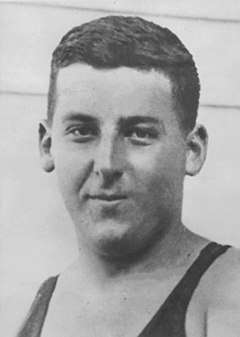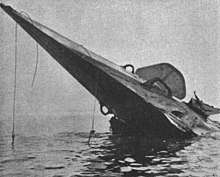Gordon Bridson
Commander Gordon Bridson, DSO, DSC (2 December 1909 – 6 December 1972) was a New Zealand swimmer who won two silver medals at the 1930 British Empire Games. During World War II, he was an officer of the Royal New Zealand Navy, and was the commander of the minesweeping trawler HMNZS Kiwi which, with her sister ship Moa, fought a classic duel with Japanese submarine I-1.
Gordon Bridson | |||||||||||||||||
|---|---|---|---|---|---|---|---|---|---|---|---|---|---|---|---|---|---|
 Bridson in 1930 | |||||||||||||||||
| Born | 2 December 1909 Wellington, New Zealand | ||||||||||||||||
| Died | 6 December 1972 (aged 63) Cambridge, New Zealand | ||||||||||||||||
| Allegiance | New Zealand | ||||||||||||||||
| Service/ | Royal New Zealand Navy | ||||||||||||||||
| Years of service | 1927–46 | ||||||||||||||||
| Rank | Commander | ||||||||||||||||
| Commands held | HMNZS Kiwi HMT Walnut | ||||||||||||||||
| Battles/wars | Second World War | ||||||||||||||||
| Awards | Distinguished Service Order Distinguished Service Cross Navy Cross (United States) | ||||||||||||||||
| Sports career | |||||||||||||||||
| Country | New Zealand | ||||||||||||||||
| Sport | Swimming | ||||||||||||||||
| Sports achievements and titles | |||||||||||||||||
| National finals | 100 yd freestyle champion (1930, 1931, 1932) 220 yd freestyle champion (1930, 1931, 1932) 440 yd freestyle champion (1929, 1930, 1931) | ||||||||||||||||
Medal record
| |||||||||||||||||
Early life
Gordon Bridson was born in Wellington in New Zealand on 2 December 1909. His parents were William Bridson, a manager, and Agnes Bridson née Gordon. The Bridson family later moved to Auckland where he grew up. He was educated at Auckland Grammar School up to six form level. He then started working at a metal merchant.[1] He began his naval career in 1927 by enlisting in the Auckland Division of the New Zealand Royal Naval Volunteer Reserve (RNVR) in Auckland. He quickly progressed to being a commissioned officer.[2]
Also an extremely accomplished swimmer, Bridson won nine national men's swimming freestyle titles over various distances from the period 1929 to 1932.[1][3] He participated in the 1930 British Empire Games in Hamilton, Ontario, where, competing for New Zealand, he won silver medals for both the 400 yards (370 m) and 1,500 yards (1,400 m) freestyle.[1][4]
Second World War
Bridson was not immediately mobilised for war service following the outbreak of the Second World War in 1939. He was called up for duty in April the following year, receiving a promotion to lieutenant commander. The next month a group of RNVR personnel, including Bridson, were dispatched to England to serve in the Royal Navy. Once in England, Bridson was given command of HMT Walnut, a Tree-class minesweeper that belonged to the 24th and 25th anti-submarine and minesweeping flotillas. He was one of ten New Zealanders commanding ships in these flotillas. For the next several months, Walnut helped protect convoys along the east coast of England and in the English Channel. He received the Distinguished Service Cross for his performance during this time.[1]
In late 1941, Bridson was appointed the commander of the newly built minesweeping trawler HMNZS Kiwi,[2] which had just been commissioned into the Royal New Zealand Navy. After initial working up in Scotland, Kiwi accompanied a convoy to cross the North Atlantic to Newfoundland. They encountered a severe storm which damaged the Kiwi which necessitated repairs in Boston before it continued onto New Zealand.[5]
Solomon Islands
Back in New Zealand, the Kiwi, together with Moa and Tui (Kiwi's two new minesweeping trawler sisters) and Matai (a converted merchant ship), into the 25th Minesweeping Flotilla. In December 1942 the flotilla set sail for deployment in the Solomon Islands.[1]
On 14 January 1943 an American PT boat fired two torpedoes at Kiwi. It was a mistake but they missed. It angered the New Zealanders, though Bridson subsequently became friends with the PT commander.Later the same month, in the late evening of 30 January, Bridson was senior officer while Kiwi jointly patrolled Guadalcanal Island with Moa. They detected the large Japanese submarine I-1. The submarine was over twice the size of the New Zealand boats, with a more powerful five-inch gun. The submarine surfaced so it could use its gun while the Kiwi attacked with depth charges. Kiwi then repeatedly rammed the submarine while firing point blank with its 4-inch gun. The Kiwi's fire capability was assisted by an unofficial 20-mm Oerlikon on its bow, which it came to possess at Noumea in exchange for two bottles of gin. Eventually, chased by Moa, the I-1 stranded and sank on a reef. The Kiwi's searchlight operator, leading signalman Buchanan, was killed, and the Kiwi had to go back to New Zealand for repairs to her bow.[1]
For his role in this action, Bridson was awarded the Distinguished Service Order[6] and the United States Navy Cross.[7]

Later military service
In May 1944 he became acting commander in Dunedin. Six months later he was made commander in charge at Lyttelton and became also an aide de camp to the Governor-General of New Zealand. He remained in these positions until the 1946 demobilisation.[1]
Later life
Returning to civilian life, Bridson moved to Te Aroha, in the North Island and became involved in the hardware trade. Several years later he took up farming on a property near Cambridge, where he died on 6 December 1972. He was survived by his wife Ada née Gilcrist, who he had married in March 1940, and three children.[1]
See also
Notes
- Dennerly, P. Y. "Bridson, Gordon". Dictionary of New Zealand Biography. Ministry for Culture and Heritage. Retrieved 19 June 2020.
- McGibbon 2000, p. 67.
- "Swimming - National Championships". Te Ara - the Encyclopedia of New Zealand. Ministry of Culture & Heritage. Retrieved 20 June 2020.
- "Gordon Bridson". New Zealand Olympic Team. New Zealand Olympic Committee. 2016. Retrieved 10 June 2017.
- McDougall 1989, pp. 55–61.
- "No. 36038". The London Gazette (Supplement). 28 May 1943. p. 2525.
- "No. 36072". The London Gazette (Supplement). 29 June 1943. p. 2948.
References
- McDougall, R. J. (1989). New Zealand Naval Vessels. Wellington, New Zealand: Government Printing Office. ISBN 978-0-477-01399-4.
- McGibbon, Ian, ed. (2000). The Oxford Companion to New Zealand Military History. Auckland, New Zealand: Oxford University Press. ISBN 0-19-558376-0.
Further reading
| Wikimedia Commons has media related to Gordon Bridson. |
- Epic sea battle. New Zealand Herald. 12 March 1943, page 2
- Obituary. The Dominion. 7 December 1972, page 7
- Harker, Jack (2000)The Rockies: New Zealand Minesweepers at War. Silver Owl Press. ISBN 0-9597979-9-8